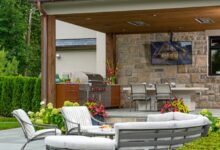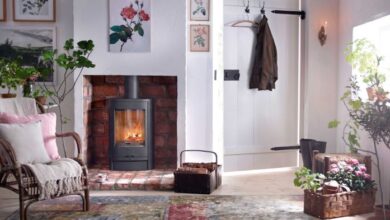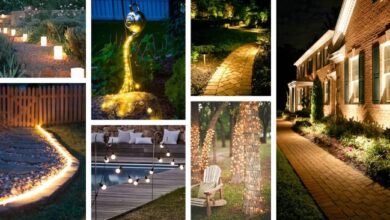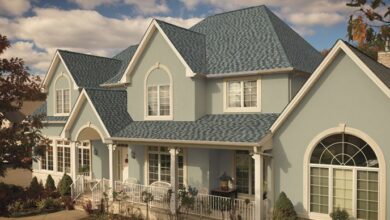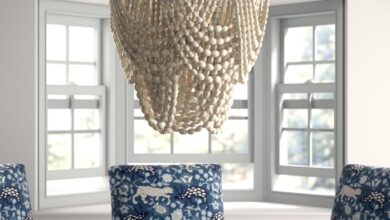Summer Outdoor Living Decor Style and Comfort
Summer outdoor living decor transforms patios and gardens into inviting havens. This guide explores diverse styles, from bohemian chic to minimalist elegance and rustic charm, highlighting key elements for creating a functional and aesthetically pleasing space. We’ll delve into lighting options, plant choices, fabric selections, furniture arrangements, and budget-friendly decorating ideas, ensuring your summer oasis is both beautiful and comfortable.
We will examine the essential elements of a successful outdoor living area, focusing on how to combine aesthetics with practicality. From selecting the perfect outdoor furniture to incorporating lush greenery and strategic lighting, we’ll provide practical advice and inspiration to help you create the perfect summer retreat. The importance of thoughtful design, considering factors such as user flow and ergonomics, will also be discussed to ensure your space is not only visually appealing but also highly functional and enjoyable.
Popular Summer Outdoor Living Decor Styles
Summer outdoor living spaces offer a fantastic opportunity to express personal style and create a relaxing retreat. Choosing the right decor style can significantly impact the overall ambiance and functionality of your outdoor area. Let’s explore three popular options that cater to diverse tastes and preferences.
Bohemian Outdoor Decor
Bohemian style embraces a free-spirited and eclectic aesthetic. Think vibrant colors, layered textures, and a mix of global influences. This style is all about creating a relaxed and inviting atmosphere, perfect for casual gatherings and lounging. Key characteristics include a rich tapestry of patterns and colors, often incorporating earthy tones with pops of bright hues like turquoise, fuchsia, and gold.
Natural materials such as woven textiles, rattan furniture, and macrame hangings are heavily featured. Furniture is typically low-slung and comfortable, encouraging a relaxed and informal setting. Think plush cushions, oversized throws, and plenty of seating options for guests. Adding elements like vintage rugs, lanterns, and potted plants further enhances the bohemian vibe. The overall effect is one of casual elegance and relaxed sophistication.
Minimalist Outdoor Decor
In contrast to the bohemian exuberance, minimalist outdoor decor prioritizes simplicity and functionality. This style focuses on clean lines, neutral color palettes, and a carefully curated selection of furniture and accessories. The emphasis is on creating a sense of calm and order, with a focus on quality over quantity. The color palette typically features muted tones like whites, grays, and beiges, complemented by natural wood accents.
Materials are chosen for their durability and clean aesthetic, often including concrete, metal, and sustainably sourced wood. Furniture is sleek and modern, with a focus on clean lines and simple forms. Accessories are kept to a minimum, with a focus on functional items that enhance the space without overwhelming it. Plants are often incorporated, but in a carefully considered manner, contributing to the overall sense of serenity.
Rustic Outdoor Decor
Rustic outdoor decor evokes a sense of warmth and natural charm. This style embraces natural materials and textures, creating a cozy and inviting atmosphere reminiscent of a countryside retreat. Think weathered wood, stone accents, and natural fabrics. The color palette often features earthy tones like browns, greens, and creams, with occasional pops of color from flowering plants or brightly colored cushions.
Materials like reclaimed wood, stone, and wrought iron are commonly used, adding to the authentic and timeworn feel. Furniture is often made from sturdy wood, sometimes featuring distressed finishes or rustic detailing. Accessories may include vintage or antique pieces, adding to the overall charm and character of the space. The overall effect is one of comfortable elegance and understated sophistication.
Comparison of Outdoor Decor Styles
| Style | Color Palette | Materials | Furniture |
|---|---|---|---|
| Bohemian | Earthy tones with bright pops of color | Woven textiles, rattan, macrame | Low-slung, comfortable, plush cushions |
| Minimalist | Muted tones, whites, grays, beiges | Concrete, metal, sustainably sourced wood | Sleek, modern, clean lines |
| Rustic | Earthy tones, browns, greens, creams | Reclaimed wood, stone, wrought iron | Sturdy wood, distressed finishes |
Essential Elements of Summer Outdoor Living Spaces
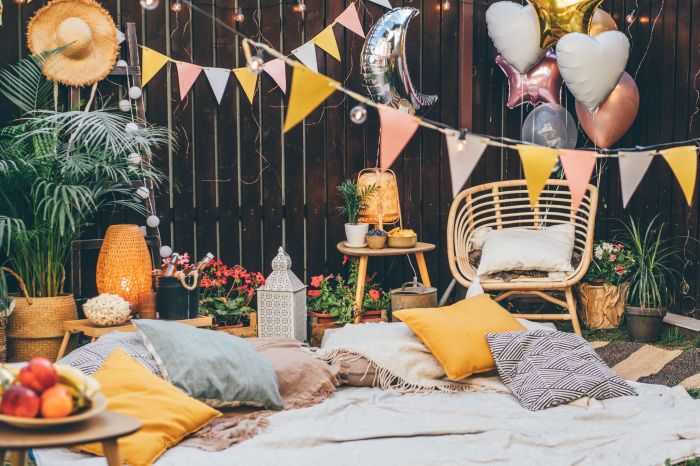
Source: hearstapps.com
Creating a truly enjoyable summer outdoor living space requires careful consideration of several key elements. These elements work together to transform a simple patio or deck into a welcoming and functional extension of your home, perfect for relaxation, entertaining, and enjoying the warm weather. The right combination of these elements can significantly enhance both the aesthetic appeal and the practical usability of your outdoor area.
Seating and Comfort
Comfortable seating is paramount for any successful outdoor living space. The type of seating you choose will depend on your personal style and the size of your area. Options range from plush cushioned sofas and armchairs to simple Adirondack chairs or woven wicker pieces. The key is to select seating that is both stylish and comfortable enough for extended periods of use.
Consider incorporating different seating options to cater to various needs and preferences, such as a larger sofa for lounging and smaller chairs for more intimate conversations. The placement of seating should also encourage conversation and interaction amongst guests. For example, arranging seating in a semi-circle around a fire pit or coffee table naturally fosters a sense of community.
Lighting
Adequate lighting is crucial for extending the usability of your outdoor space into the evening hours. Strategic lighting not only provides practical illumination but also enhances the ambiance and mood. Consider a layered approach, incorporating different types of lighting to create a warm and inviting atmosphere. Ambient lighting, such as string lights or lanterns, provides a soft, overall glow.
Task lighting, such as spotlights or path lights, illuminates specific areas for safety and functionality. Accent lighting, such as uplights on plants or architectural features, highlights key elements and adds depth to the space.
Plants and Greenery
Plants play a vital role in creating a lush and inviting outdoor oasis. They soften hard surfaces, add color and texture, and provide a sense of privacy. The selection of plants will depend on your climate, soil conditions, and personal preferences. Consider a mix of different heights, textures, and colors to create visual interest. Potted plants are a versatile option, allowing for easy rearrangement and seasonal changes.
Larger shrubs or trees can provide shade and create a more enclosed feeling. Remember to choose plants that are appropriate for the amount of sunlight your space receives.
Shade and Protection from the Elements
Summer heat can be intense, so providing adequate shade is essential for comfortable outdoor living. A pergola, awning, or large umbrella can offer protection from the sun’s rays. Consider also the potential for rain or wind. A covered patio or strategically placed screens can offer protection from these elements, allowing you to enjoy your outdoor space regardless of the weather.
The choice of shade solution should complement the overall style of your outdoor space and provide adequate coverage for your seating area.
Outdoor Accessories and Decor
Accessories and decor are what truly personalize your outdoor space and reflect your style. This can include everything from outdoor rugs and cushions to decorative planters, artwork, and lighting fixtures. These elements add warmth, personality, and visual interest. A well-placed outdoor rug can define the seating area and add a pop of color. Cushions and throws add comfort and style.
Consider incorporating items that are both functional and aesthetically pleasing, such as a fire pit for warmth and ambiance, or a water feature for a calming soundscape.
Sample Layout for a Small Patio
A successful small patio design balances functionality and aesthetics. Here’s a suggested layout incorporating the five essential elements:
- Seating Area: A small bistro set (two chairs and a small table) placed centrally, leaving ample space for movement.
- Lighting: String lights draped across the patio ceiling or strung along a nearby wall for soft ambient lighting. A small solar-powered lantern placed on the table for task lighting.
- Plants: Two large potted plants (e.g., ferns or flowering shrubs) flanking the seating area, adding vertical interest and a touch of greenery.
- Shade: A freestanding umbrella positioned above the seating area, providing protection from the sun.
- Accessories: A small outdoor rug placed under the bistro set to define the seating area and add warmth. Colorful cushions added to the chairs for extra comfort.
Summer Outdoor Lighting Ideas

Source: ebayimg.com
Summer evenings spent outdoors are significantly enhanced by the right lighting. Choosing the appropriate lighting not only illuminates your space but also sets the mood and atmosphere, transforming your outdoor area into a welcoming and enjoyable retreat. The selection depends largely on personal preference, the overall design aesthetic, and the specific needs of the space.
String Lights: A Versatile and Popular Choice
String lights offer a versatile and widely popular lighting solution for summer outdoor spaces. Their affordability and ease of installation make them a favorite among homeowners. They come in various styles, including classic Edison bulbs, globe lights, and fairy lights, allowing for customization to match any décor.
- Advantages: String lights are inexpensive, easy to install (often requiring only simple hooks or clips), and create a warm, inviting ambiance. They are available in a wide range of colors and styles, providing flexibility in design. Their low-voltage nature generally makes them safe for outdoor use.
- Disadvantages: String lights can be fragile and susceptible to damage from weather. Their light output is relatively low, making them less suitable for areas requiring bright illumination. They may require frequent replacement if not weatherproofed adequately.
Creative uses include draping them across pergolas, wrapping them around trees, or using them to delineate pathways. Imagine a string of warm-white Edison bulbs creating a magical glow along a patio’s edge, highlighting the summer blooms in nearby planters.
Lanterns: Adding a Touch of Elegance and Warmth
Lanterns provide a more sophisticated and elegant lighting option compared to string lights. They offer a focused light source and come in diverse materials, from traditional metal to sleek glass designs.
- Advantages: Lanterns add a touch of charm and sophistication to any outdoor setting. They offer a more focused light source than string lights, perfect for highlighting specific areas or features. They are available in a variety of styles and materials, making them adaptable to various design aesthetics.
- Disadvantages: Lanterns can be more expensive than string lights. They require a reliable light source, such as candles (requiring safety precautions) or battery-operated LED inserts. They may also require more careful placement and maintenance than string lights.
Consider placing a cluster of elegant metal lanterns on a garden table to create a focal point for evening gatherings, or line a walkway with smaller lanterns for a charming, romantic ambiance. The soft glow emanating from these lanterns creates a sense of tranquility and warmth.
Solar Path Lights: A Sustainable and Convenient Option
Solar path lights offer a sustainable and convenient solution for illuminating pathways and walkways. These lights harness solar energy during the day and automatically illuminate at night, requiring no wiring or electricity.
- Advantages: Solar path lights are environmentally friendly, requiring no external power source. They are easy to install, simply requiring placement along the desired path. Their low maintenance needs make them a practical choice.
- Disadvantages: The brightness of solar path lights is often limited, and their effectiveness depends on adequate sunlight exposure. They may not provide sufficient illumination in areas with limited sunlight or during cloudy weather. The battery life may also vary depending on weather conditions and the quality of the lights.
Imagine a pathway lined with solar-powered lights, guiding guests safely to your outdoor entertainment area. The soft, gentle glow they provide creates a welcoming atmosphere without being overly bright or intrusive. They can easily be integrated into various landscaping designs, adding a touch of subtle elegance.
Incorporating Plants and Greenery
Plants are fundamental to creating a truly inviting and aesthetically pleasing outdoor living space. They soften hard lines, add texture and color, and contribute significantly to the overall ambiance. The strategic placement of greenery can transform a simple patio into a tranquil oasis or a stark deck into a vibrant, welcoming area perfect for relaxation and entertaining. Beyond aesthetics, plants also offer practical benefits, such as providing shade, improving air quality, and even reducing noise pollution.The incorporation of plants into your outdoor design offers a wide range of possibilities, allowing for both creativity and practicality.
The choice of how to incorporate plants depends largely on the existing space, your personal style, and the level of maintenance you’re willing to undertake. Different approaches can cater to various needs and preferences, maximizing both visual appeal and functionality.
Methods for Incorporating Plants
Several methods exist for successfully integrating plants into your outdoor living area. Planters, in various sizes and materials, offer a flexible and portable solution, allowing for easy rearrangement and seasonal changes. Large terracotta pots filled with flowering plants can create focal points, while smaller containers can be used to line pathways or add pops of color along railings. Hanging baskets, suspended from ceilings, trees, or fences, add vertical interest and create a sense of airiness, especially effective in smaller spaces.
Vertical gardens, utilizing walls or fences, maximize space utilization, especially beneficial in areas with limited ground space. These vertical gardens can be created using various systems, from simple trellises to more complex hydroponic setups.
Low-Maintenance Plants for Summer Outdoor Settings
Choosing low-maintenance plants is crucial for maintaining a beautiful outdoor space without dedicating excessive time and effort. These plants are resilient and can withstand the challenges of summer weather, such as heat, drought, and occasional neglect.
- Lavender: Known for its fragrant purple flowers and tolerance to drought and heat. Lavender thrives in full sun and well-drained soil, requiring minimal watering once established.
- Rosemary: This aromatic herb is incredibly hardy and drought-tolerant, making it ideal for hot and sunny locations. It also adds a culinary element to your outdoor space.
- Sedum (Stonecrop): These succulents are incredibly low-maintenance, thriving in full sun and requiring minimal watering. They come in a variety of colors and textures, adding visual interest to rock gardens or containers.
- Coneflowers (Echinacea): These daisy-like flowers attract pollinators and are highly resistant to pests and diseases. They tolerate full sun and require minimal watering.
- Lantana: A vibrant flowering plant that attracts butterflies and tolerates heat and drought well. Lantana comes in a variety of colors and is relatively pest-resistant.
Summer Outdoor Textiles and Fabrics
Choosing the right fabrics for your outdoor summer living space is crucial for both comfort and longevity. The harsh summer sun, rain showers, and occasional spills demand durable and weather-resistant materials that can withstand the elements and maintain their aesthetic appeal throughout the season. The selection process should consider factors such as durability, ease of maintenance, and aesthetic harmony with your overall design scheme.
Several fabrics excel in outdoor applications, each offering a unique blend of properties. Understanding these differences will help you make informed decisions based on your specific needs and preferences. Key factors to consider include resistance to fading, water repellency, and the fabric’s ability to resist mildew and mold growth.
Fabric Choices for Outdoor Cushions, Pillows, and Throws
Sunbrella, canvas, and cotton are three common choices for outdoor textiles, each possessing distinct advantages and disadvantages. Sunbrella, a solution-dyed acrylic fabric, is renowned for its exceptional resistance to fading, mildew, and staining. Its vibrant colors remain true even under prolonged sun exposure, making it an ideal choice for high-traffic areas. Canvas, a heavier-weight fabric, offers excellent durability and water resistance, although it may require more frequent cleaning and is susceptible to fading over time compared to Sunbrella.
Cotton, while comfortable and aesthetically pleasing, is less durable and weather-resistant than Sunbrella or canvas. It’s prone to fading, shrinking, and mildew growth if not properly treated and stored. For optimal performance, choose treated cotton designed specifically for outdoor use.
Durability and Weather Resistance Comparison
| Fabric | Durability | Fade Resistance | Water Resistance | Mildew Resistance | Maintenance |
|---|---|---|---|---|---|
| Sunbrella | Excellent | Excellent | Good | Excellent | Easy |
| Canvas | Good | Moderate | Good | Moderate | Moderate |
| Cotton (Outdoor Treated) | Moderate | Poor | Poor | Poor | High |
Mediterranean Themed Outdoor Fabric Mood Board
Imagine a sun-drenched Mediterranean patio. The ideal fabric choices would evoke the region’s vibrant colors and relaxed atmosphere. For cushions and pillows, envision a palette of creamy whites, sun-bleached yellows, and deep azure blues, reminiscent of the sea and sky. Subtle patterns could include stripes inspired by traditional Greek pottery or geometric designs echoing Moorish architecture. Textures should be rich and inviting, with linen blends offering a slightly textured surface, and heavier cotton canvas for added durability.
Throws could incorporate bolder patterns, such as intricate floral designs or traditional ikat prints in warm terracotta and olive green tones. The overall effect should be one of relaxed elegance, reflecting the warmth and beauty of the Mediterranean landscape. The textures would be a mix of soft linen and heavier, durable canvas, chosen for their ability to withstand the elements while maintaining comfort.
Creating a Comfortable and Functional Outdoor Space: Summer Outdoor Living Decor
Designing a comfortable and functional outdoor space involves careful consideration of furniture selection, arrangement, and overall ergonomics. The goal is to create an inviting area that seamlessly blends style and practicality, encouraging relaxation and social interaction. This requires a thoughtful approach to both aesthetics and user experience.Choosing outdoor furniture that balances style and comfort is crucial. Durability is paramount, as outdoor furniture faces exposure to the elements.
Materials like weather-resistant wicker, powder-coated aluminum, or teak wood offer both aesthetic appeal and longevity. Consider cushions and seating that are comfortable for extended periods. Deep seating options, such as generously sized sofas and armchairs, encourage relaxation. Look for furniture with features like adjustable backrests or footrests for personalized comfort. For example, a modular sectional sofa allows for flexible configuration to adapt to different group sizes and spatial needs.
Furniture Arrangement for Maximum Space Utilization and Varied Seating Areas, Summer outdoor living decor
Effective furniture arrangement is key to maximizing space and creating distinct seating zones within your outdoor area. Consider the flow of movement and conversation. A central coffee table can anchor a main seating area, while smaller side tables provide convenient surfaces for drinks and snacks. For larger spaces, consider creating separate areas for dining, lounging, and perhaps even a quiet reading nook.
For example, a patio might feature a large dining table with chairs at one end, a comfortable seating group with a fire pit in the center, and a secluded bench tucked away amongst plants for a quiet escape. This zoning approach prevents overcrowding and allows for diverse activities. A curved sofa arrangement can create a more intimate feel, while straight lines offer a more formal look.
Ergonomics and User Experience in Outdoor Seating Design
Ergonomics plays a crucial role in creating a truly comfortable outdoor space. Consider seating height, backrest support, and armrest placement. Seating that is too low or too high can cause discomfort. Adequate backrest support is essential for preventing back strain, especially during prolonged periods of sitting. Armrests should be positioned to provide comfortable support without restricting movement.
The user flow should be considered, ensuring easy access to seating areas and convenient placement of tables and other amenities. Avoid placing furniture in direct pathways or in areas that obstruct movement. For instance, pathways should be at least 3 feet wide to allow for comfortable passage, even when furniture is in place. The arrangement of furniture should encourage natural conversation flow, placing seating areas at comfortable distances for easy interaction.
Budget-Friendly Summer Outdoor Decor Ideas
Creating a beautiful and inviting outdoor space doesn’t require breaking the bank. With a little creativity and resourcefulness, you can transform your patio, deck, or yard into a summer oasis without exceeding your budget. This section explores several cost-effective strategies for achieving a stylish and functional outdoor living area.
Repurposing and Upcycling for Outdoor Decor
Repurposing and upcycling existing items is a fantastic way to save money and add unique character to your outdoor space. Old items often hold untapped potential for stylish outdoor decor. For example, old wooden pallets can be easily transformed into stylish outdoor seating or a unique vertical garden. A collection of mismatched teacups can be repurposed into charming planters for herbs or flowers.
Similarly, old jars and bottles, cleaned and painted, can become elegant candle holders, adding a warm and inviting ambiance to your evening gatherings. Even old window frames can be repurposed into attractive wall art, adding a touch of rustic charm. The possibilities are virtually endless, limited only by your imagination and the available materials.
Affordable Outdoor Furniture and Accessory Sourcing
Finding affordable yet stylish outdoor furniture and accessories requires a strategic approach. Thrift stores and secondhand shops are treasure troves of inexpensive finds, often offering high-quality furniture at a fraction of the retail price. Online marketplaces and classified ads can also yield great deals on gently used or even new outdoor furniture. Consider looking for items at the end of the season sales for significant discounts.
Remember, a little sanding, painting, or reupholstering can breathe new life into older pieces, transforming them into unique statement pieces for your outdoor space.
Five Cost-Effective Outdoor Decor Ideas
Transforming your outdoor space on a budget is achievable with simple yet impactful changes. Here are five cost-effective ideas:
- String Lights: Create a magical ambiance with affordable string lights. Drape them across trees, along fences, or around your patio furniture for a warm and inviting glow in the evenings. The warm, inviting light creates a relaxing atmosphere perfect for summer evenings.
- Mason Jar Lanterns: Repurpose mason jars by adding tea lights or battery-operated candles inside. These simple lanterns add a rustic charm to any outdoor setting, particularly when grouped together. The soft light emanating from the jars creates a cozy and intimate atmosphere.
- DIY Planters: Create unique planters using repurposed items like old buckets, watering cans, or even teapots. A fresh coat of paint and some vibrant flowers will instantly brighten up your space. This adds a touch of personalization and creativity to the decor.
- Outdoor Rugs: A durable outdoor rug can define your seating area and add a pop of color and texture. Look for sales or discounts on outdoor rugs to find a stylish option within your budget. The rug grounds the space and adds a feeling of comfort and sophistication.
- Natural Elements: Incorporate natural elements like stones, driftwood, and pinecones to create a rustic and inviting atmosphere. These readily available materials add a unique touch without costing anything. They blend seamlessly with the natural environment and add a touch of organic beauty.
Utilizing Free or Low-Cost Natural Decor
Nature offers a wealth of free or low-cost decorative elements. Gather fallen branches, pinecones, and stones to create unique centerpieces or decorative accents. These natural elements add a rustic and organic touch to your outdoor space, complementing the summery ambiance. Consider arranging stones to create a pathway or using branches to craft a rustic frame for a mirror or artwork.
These simple additions can significantly enhance the aesthetic appeal of your outdoor area.
Closing Notes
Designing a captivating summer outdoor living space involves a thoughtful blend of style, comfort, and functionality. By carefully considering elements such as lighting, plants, fabrics, and furniture, you can create a welcoming and enjoyable environment that perfectly complements your personal style and enhances your summer experience. Remember that even budget-conscious approaches can yield stunning results with a little creativity and resourcefulness.
Embrace the possibilities and transform your outdoor area into a cherished summer retreat.
Questions and Answers
What are some popular summer outdoor color palettes?
Popular palettes include bright, cheerful colors like yellows, oranges, and turquoise, as well as softer, more neutral tones like beige, gray, and white. Consider your existing home’s exterior and your personal preference when selecting a palette.
How do I protect outdoor furniture from the elements?
Use weather-resistant fabrics and finishes. Consider investing in protective covers during periods of inclement weather. Regularly clean and maintain your furniture to prolong its lifespan.
What are some low-maintenance plants for a summer garden?
Succulents, herbs (like rosemary and lavender), and drought-tolerant grasses are excellent choices. Research plants suitable for your specific climate and sun exposure.
How can I create different seating areas in a small outdoor space?
Use rugs to define different zones. Consider incorporating a variety of seating options, such as a bistro set for two and larger seating arrangements for groups.
Where can I find affordable outdoor decor?
Thrift stores, flea markets, and online marketplaces offer great deals. Repurposing and upcycling existing items can also be a cost-effective way to add unique touches to your space.


